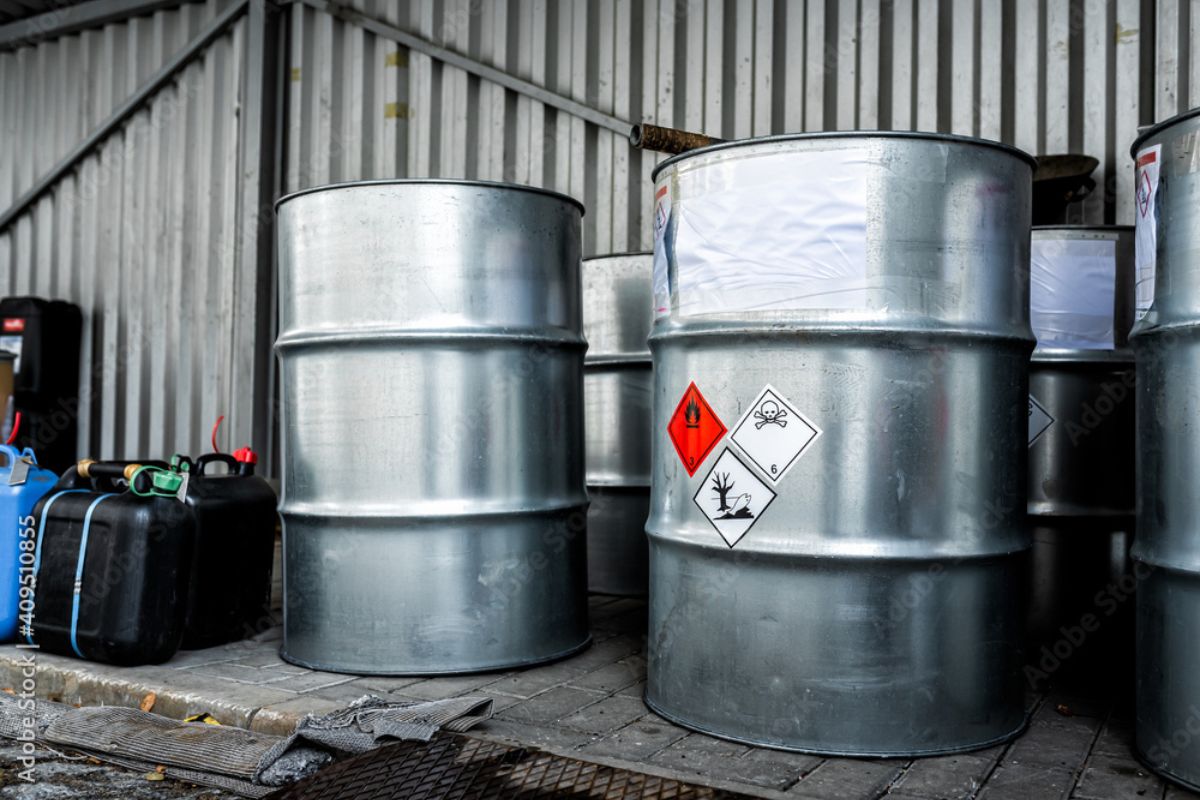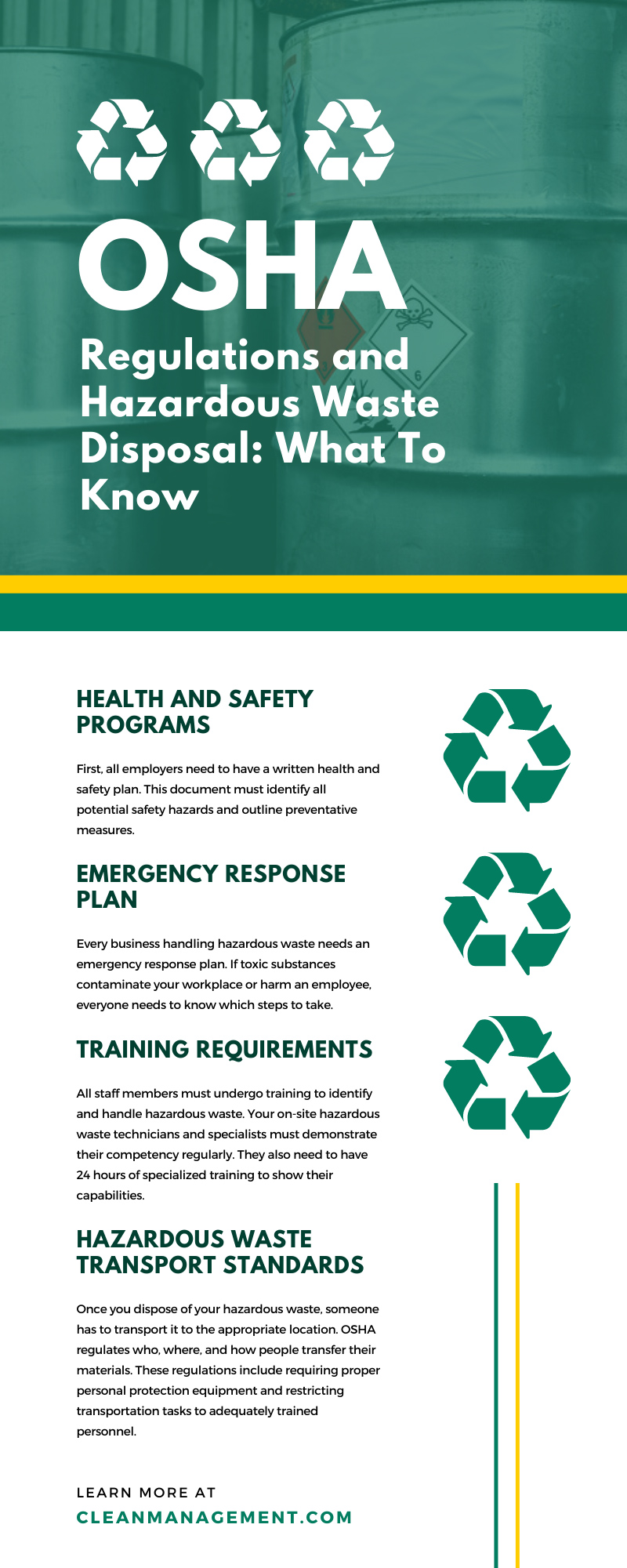OSHA Regulations and Hazardous Waste Disposal: What To Know

In the 1970s, the United States Department of Labor established the Occupational Safety and Health Administration, or OSHA. This entity is responsible for protecting workers’ rights to a safe workplace. OSHA sets safety standards that employers must meet to avoid harsh monetary and legal consequences.
Workplaces that deal with hazardous waste must take OSHA guidelines very seriously. However, understanding all the legal jargon can get confusing. Fortunately, Clean Management Environmental Group has everything you need to know about OSHA regulations and hazardous waste disposal.
What Does OSHA Consider To Be Hazardous Waste?
OSHA works closely with the Environmental Protection Agency and Department of Transportation to define hazardous waste. Therefore, their definition closely aligns with these agencies to reduce confusion.
According to OSHA, hazardous waste is any agent that can cause bodily or environmental harm. This includes biological agents and corrosive chemicals, as well as machines, tools, and equipment common to industrial and construction sites. Employers can find comprehensive lists of all toxic chemical agents and specific waste products on OSHA’s website.
OSHA’s Hazardous Waste Disposal Requirements
OSHA sets the standard for workplace safety. As such, they have guidelines that demand health programs, emergency plans, training requirements, and transportation rules.
Below, we’ve summarized what you need to know about OSHA regulations and hazardous waste disposal. Make sure your business adheres to the recommendations to maintain a safe and healthy workplace for everyone.
Health and Safety Programs
First, all employers need to have a written health and safety plan. This document must identify all potential safety hazards and outline preventative measures. To draft an efficient health and safety plan, OSHA recommends allowing qualified professionals like Clean Management Environmental Group to perform preliminary inspections.
Your health safety plan should also include:
- A site map with documented work zones
- Monitoring and reduction plans
- Decontamination processes
- Emergency response resources
Emergency Response Plan
Every business handling hazardous waste needs an emergency response plan. If toxic substances contaminate your workplace or harm an employee, everyone needs to know which steps to take.
Your emergency response plan should include choreographed actions, evacuation routes, and clear lines of communication. You should also be transparent about who maintains authority when it comes to these situations; this way, your employees have an understanding of who to follow.
Training Requirements
All staff members must undergo training to identify and handle hazardous waste. This training should also include response options in case of an emergency. Hazardous waste operations personnel need:
- 40 hours of initial and three days of field training for regular site visits
- 24 hours of initial and one day of field training for occasional site visits
- Eight additional hours for managers and supervisors
- Eight hours of refresher training annually
Your on-site hazardous waste technicians and specialists must demonstrate their competency regularly. They also need to have 24 hours of specialized training to show their capabilities. RCRA-certified facilities must offer 24 hours of initial and eight hours of annual training to employees who handle and store their toxic substances.
Hazardous Waste Transport Standards
Once you dispose of your hazardous waste, someone has to transport it to the appropriate location. OSHA regulates who, where, and how people transfer their materials. These regulations include requiring proper personal protection equipment and restricting transportation tasks to adequately trained personnel.
Common Problems Facilities Face and Their Solutions
All this information is useless if you don’t know how to apply it. Businesses come under fire every day for breaking OSHA regulations regarding hazardous waste. If you notice any of these problems in your facility, take the appropriate measures to correct them to encourage a safe environment.
Problem: Ineffective Health and Safety Programs
Many facilities have health and safety programs that just don’t work. Passing out memos and directing staff members to resource pages isn’t enough. Your employees must demonstrate that they understand how to identify, handle, store, and dispose of hazardous waste correctly.
Solution: Hire a Health and Safety Manager
The best way to enforce an efficient plan is to hire a health and safety manager. This person should undergo enough training to answer any questions and make recommendations. An on-site team of hazardous waste experts will know the ins and outs of your plan and make sure everyone follows accordingly.
Problem: Outdated Safety and Emergency Plans
Many businesses take OSHA regulations seriously in the beginning. However, people can regularly forget to update their emergency plans. Outdated site maps, evacuation routes, and lines of authority make communication impossible during times of stress.
Solution: Create a Working Document
To combat this problem, create a working document for your safety and emergency plans. Authorized team members, like your health and safety manager, will update this document whenever your facility changes. New site maps, emergency routes, and procedures will reflect your current conditions.
Problem: Poor Emergency Response Planning
Your emergency response plan for hazardous waste might be your most important document. However, many companies use complicated jargon and unclear instructions. They also fail to practice their responses, thinking they’ll never have to actually use these resources.
Solution: Perform Training Exercises To Prepare Employees
Emergencies can happen at any time, especially when hazardous waste is involved. OSHA requires facilities to train and practice responses with their employees. This way, all staff members know how to react in any given scenario to control contamination and protect themselves from harm.
Why Do OSHA Regulations About Hazardous Waste Matter?
Hazardous waste regulations might not seem like a big deal. However, OSHA violations cost thousands of dollars in civil consequences. After so many infractions, you could lose your right to perform business altogether.
Monetary punishments are only the tip of the iceberg. People don’t want to work for an establishment that doesn’t prioritize their well-being. Consumers often spend money with their hearts; they won’t continue to patronize facilities that put their employees and the environment at risk with their hazardous waste disposal methods.
The good news is that adhering to OSHA regulations isn’t as challenging as it seems. Clean Management Environmental Group specializes in proper hazardous waste transportation and disposal. Our trained professionals will handle and transfer your dangerous substances while following every OSHA guideline.
We can also train your staff, audit your current practices, and make recommendations to create a safer working environment. You’ll never have to worry about making mistakes and violating OSHA’s hazardous waste disposal standards. Contact us today and let us know how we can help!

